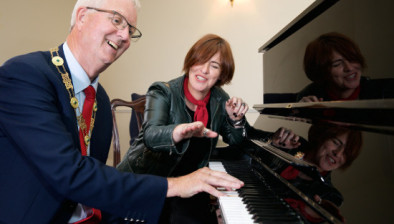CJEU: General Court annuls EUIPO decision over ‘Chiara Ferragni’ trade mark
The General Court has annulled European Intellectual Property Office (EUIPO) decision refusing registration of the figurative mark ‘Chiara Ferragni’ as an EU trade mark
In 2015, Italian entrepreneurs filed an application with EUIPO for registration of the following EU trade mark, which they had been using, for, among others, goods in Classes 18 and 25 of the international classification:

A Dutch company filed a notice of opposition to the registration of that figurative mark, alleging a likelihood of confusion with the earlier word mark ‘Chiara’, registered in Benelux in 2015 for goods in Class 25, among others.
In 2017, following the filing of that notice of opposition, EUIPO refused to register the figurative mark ‘Chiara Ferragni’ as an EU trade mark for, among other things, ‘bags, haversacks; key cases; leather purses’ in Class 18 and all goods in Class 25, because there was a likelihood of confusion between the signs at issue.
The users of the mark ‘Chiara Ferragni’ then brought an action before the General Court seeking the annulment of EUIPO’s decision.
In its judgment, the General court annuls EUIPO’s decision.
The court notes, first of all, that the average consumer perceives a mark as a whole and the mark applied for is a composite mark composed of both word and figurative elements. It is, in fact, composed of two word elements, ‘chiara’ and ‘ferragni’, in black capital letters, with the letters ‘i’ in bold, and a figurative element, positioned above the word elements, consisting of a drawing representing a sky blue eye with long black lashes.
Those long lashes look like the letter ‘i’ in the words ‘chiara’ and ‘ferragni’. The court states that the highly stylised nature, colour, position and size of the figurative element are likely to divert the relevant public’s attention away from the word element, which is positioned in the lower part of the mark applied for. In essence, the figurative element of the mark applied for is at least as distinctive as the word elements of the mark taken as a whole. EUIPO was therefore wrong to attach greater importance to the word element ‘chiara’ than to the figurative element.
The court goes on to assess the visual, phonetic and conceptual similarity of the marks at issue.
As regards visual similarity, the court notes that, although the earlier word mark ‘chiara’ is entirely reproduced in the word elements of the mark applied for, ‘chiara ferragni’, the figurative element of the latter has a significant impact in the overall visual impression. On that basis, the court concludes that the two signs at issue are, at most, only slightly visually similar.
As regards the phonetic comparison, the court finds that the distinguishing feature, ‘ferragni’, given its length, is phonetically more important than the similar element, ‘chiara’, even though it is positioned after that element. Therefore, the two signs at issue have an ‘average’ or even ‘slight’ phonetic similarity.
The court also states that the two signs at issue are conceptually different, since the mark applied for identifies a specific person, while the earlier word mark merely refers to a first name, without identifying a specific person.
The court then analyses the likelihood of confusion between the two marks and states that, despite the fact that the goods in question are identical or similar, the differences between the signs at issue, particularly the visual differences, provide sufficient grounds to rule out any likelihood of confusion on the part of the public.
As the goods in question are generally sold in self-service stores where decisions to purchase are mainly based on visual criteria, the differences between the two marks mean that consumers will not think that the goods come from the same undertaking or from economically-linked undertakings when they bear the marks at issue. The court therefore concludes that EUIPO erred in finding that there was a likelihood of confusion.









